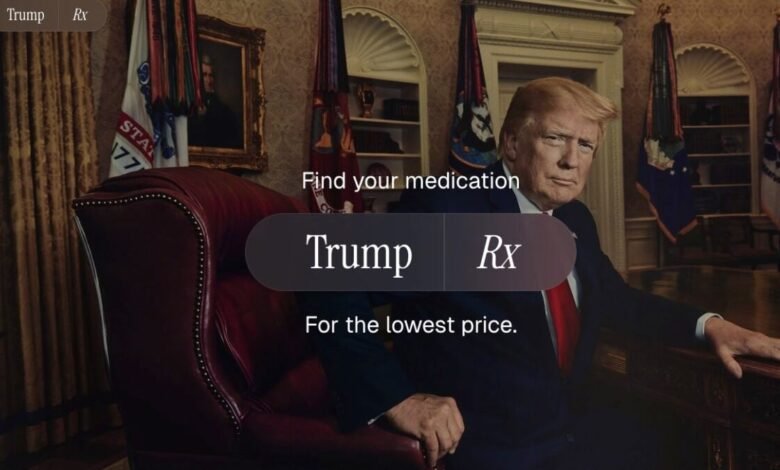TrumpRx: The AI-Generated Nightmare

▼ Summary
– Donald Trump launched the TrumpRx government website during a White House press conference, which is currently non-functional and scheduled to become operational in January 2026.
– The website prominently features Trump’s image and branding, including a photo of him in the Oval Office, and is criticized for prioritizing his personal brand over public service.
– An AI-generated image on the site displays anatomical inaccuracies, such as distorted hands and feet, raising concerns about the site’s professionalism and reliability.
– TrumpRx claims to lower prescription drug costs by increasing transparency and cutting out third-party markups, but critics argue it has not actually reduced prices and may primarily benefit cash-paying customers.
– The website is linked to the National Design Studio and has ties to Trump’s family, with his son Donald Trump Jr. involved in a related company that could profit from the initiative.
The newly unveiled TrumpRx.gov website, announced by President Donald Trump, aims to reshape how Americans access prescription medications by promising direct price connections and increased transparency. However, the platform’s launch has drawn immediate criticism for its heavy focus on the president’s personal branding and the questionable quality of its imagery, raising doubts about its potential effectiveness.
Upon visiting the site, users are immediately greeted by a prominent photograph of Trump in the Oval Office, reinforcing his tendency to place his personal brand at the forefront of government initiatives. This stands in stark contrast to the launch of Healthcare.gov under the Obama administration, which did not feature any images of the former president. The decision to so prominently feature Trump has been met with disapproval from those who view it as an inappropriate blending of official government business with personal promotion.
Beyond the presidential portrait, another image on the site has sparked confusion and concern. A stock photo depicting a family on a beach appears to have been generated by artificial intelligence, a choice that seems both unnecessary and unprofessional given the availability of authentic photography. A closer inspection reveals several anatomical inaccuracies typical of AI-generated visuals. The subjects’ hands are distorted with contorted fingers, one child’s foot appears to have an abnormal number of toes, and lower limbs show unusual proportions that defy human anatomy. Even the background details, such as the pattern of holes in the sand, look artificially generated rather than natural.
The website is a product of the National Design Studio, an entity Trump established via executive order. The language used on the studio’s own site further emphasizes the president’s branding, describing the “Trump” name as one of the world’s most powerful brands, intrinsically linked to the United States itself. This fusion of national identity with personal branding has struck many observers as unsettling for a government initiative.
During his press conference, Trump claimed the name “TrumpRx” was not his idea, though his well-documented history of putting his name on various products and properties makes this assertion difficult to accept. The website’s text makes bold claims about the president delivering on promises that “experts” deemed impossible, specifically regarding lowering prescription drug costs for American families without sacrificing innovation.
The reality of Trump’s drug pricing initiatives tells a different story. Despite numerous announcements about deals to reduce costs, pharmaceutical company stock prices have consistently risen following these declarations, suggesting investors don’t anticipate significant impacts on profit margins. The limited price reductions that have occurred primarily benefit cash-paying customers rather than the majority of Americans who purchase medications through insurance. Meanwhile, insurance premiums are projected to increase for many under Trump’s healthcare policies, potentially offsetting any minor savings on specific prescriptions.
The press conference featured several controversial figures, including Medicare and Medicaid administrator Mehmet Oz and Health Secretary Robert F. Kennedy Jr., whose past statements questioning expert opinion and demonstrating factual inaccuracies about basic human biology have raised concerns about the administration’s approach to healthcare policy.
Perhaps most concerning are the financial connections surrounding the initiative. Reports indicate that Donald Trump Jr. sits on the board of BlinkRx, a company that could significantly benefit from the TrumpRx platform. With the younger Trump scheduled to host a “Future of Pharmaceuticals” summit in December, drug industry representatives have expressed apprehension about potentially being compelled to work with a company so closely connected to the president’s family.
While the TrumpRx website promises to “connect patients directly with the best prices” without actually selling medications itself, the operational details remain unclear. What is evident is the administration’s pattern of making grand promises about healthcare reform while creating opportunities for those with personal connections to benefit. Given this track record and the questionable presentation of the initiative, many Americans remain skeptical that TrumpRx will deliver meaningful relief from high drug costs.
(Source: Gizmodo)